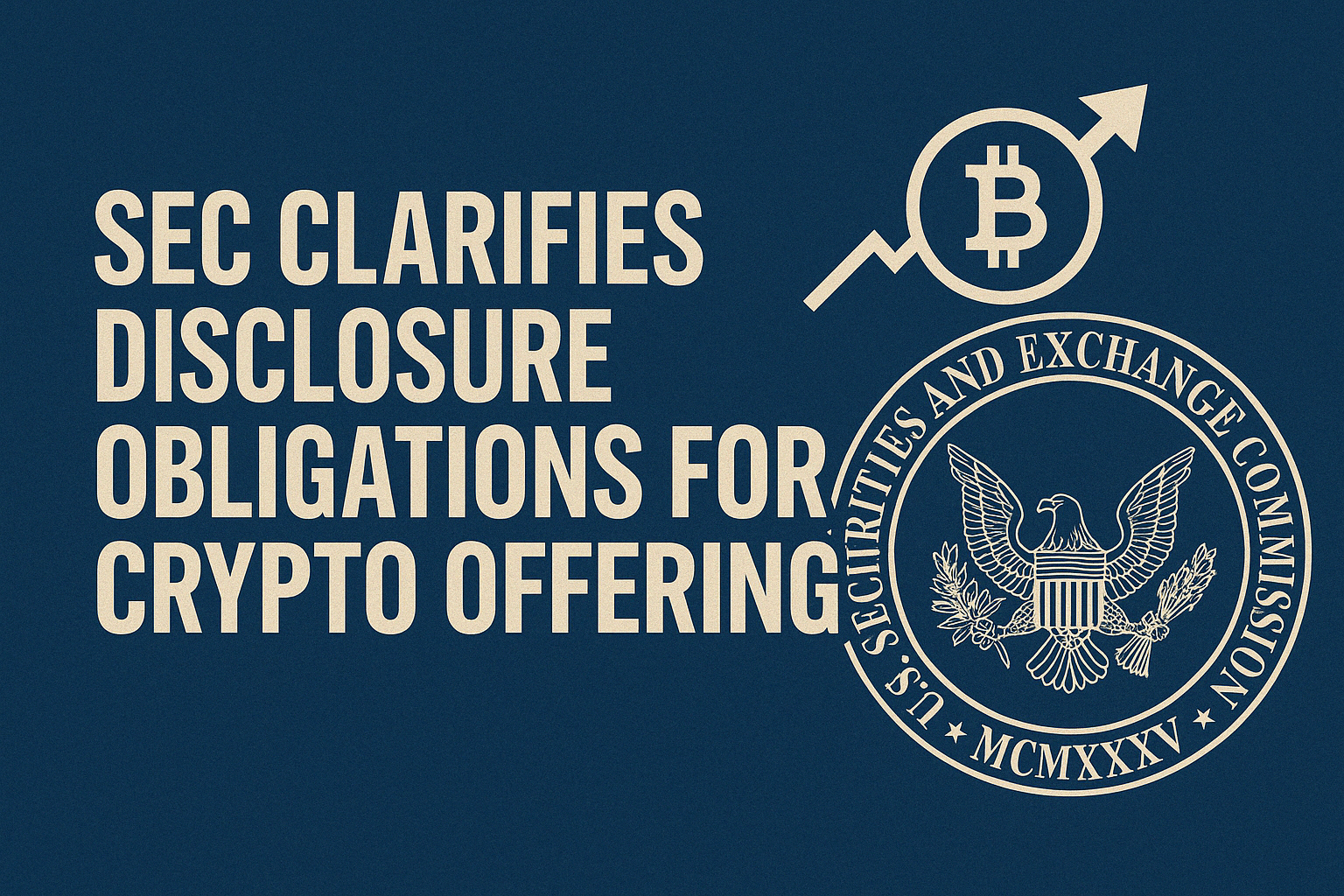
Introduction: A Regulatory Step Toward Clarity
On April 10, 2025, the U.S. Securities and Exchange Commission (SEC) issued a crucial statement via the Division of Corporation Finance. Titled “Offerings and Registrations of Securities in the Crypto Asset Markets,” this guidance marks an important step in clarifying how securities laws apply to crypto asset-related offerings.
While the SEC does not outright declare whether specific crypto assets qualify as securities, the focus of this statement is clear: transparency and robust disclosure are essential when raising capital or offering investment opportunities in the digital asset space.
Why This Statement Matters
The crypto industry has long operated in a regulatory gray zone, with ongoing debates around whether tokens, stablecoins, and digital representations of assets fall under existing securities law. This latest guidance aims to help companies navigate that uncertainty—especially those whose operations intersect with tokenized assets, crypto networks, or blockchain applications.
In practical terms, the SEC is saying: If you’re involved with crypto in any significant way—and especially if you’re raising money—you need to disclose material facts to your investors in line with federal securities law.
What the Guidance Covers
The statement focuses on two key areas of concern for the SEC:
1. Offerings and Registrations Involving Crypto-Related Securities
The SEC clarifies that issuers involved in any of the following scenarios must pay close attention to the disclosure obligations under U.S. securities laws:
-
Equity or debt securities of companies with business models reliant on crypto networks, blockchains, or crypto assets.
-
Crypto assets that are offered as part of or in connection with an investment contract, which would likely fall under the definition of a security.
This means that even if a company isn’t directly issuing a token but operates within the crypto ecosystem (e.g., mining, staking, custody, or infrastructure), it must still comply with relevant securities regulations if raising capital through securities offerings.
2. Disclosure Expectations for Crypto-Linked Issuers
The core message here: disclosure is key.
Issuers must clearly and comprehensively inform investors about:
-
The company’s business model and its reliance on crypto assets.
-
The design, utility, governance, and risks associated with any crypto asset involved.
-
The nature of the rights granted to holders of those assets (if any).
-
The degree to which a crypto asset is dependent on the efforts of others (a Howey test indicator).
-
Any impact of potential or pending regulatory changes on the issuer’s business.
This echoes the broader goals of investor protection and fair markets—foundational principles of the SEC’s mission.
Commissioner Peirce’s Perspective
SEC Commissioner Hester M. Peirce—widely known as “Crypto Mom” for her balanced, innovation-forward stance—released a parallel statement clarifying that this isn’t a comprehensive rulebook. Instead, it’s a directional guide, helping crypto-affiliated companies understand the kinds of disclosures investors should expect.
Her statement adds:
“This is not a how-to guide, but a good starting point. We need to move past ambiguity and into action. Crypto projects that raise capital from the public must be clear and forthcoming.”
She also cautioned against turning these insights into rigid checklists, emphasizing the need for project-specific analysis and disclosures tailored to each business model.
What This Means for the Industry
The SEC’s latest guidance reinforces several important regulatory signals for the crypto industry:
1. The SEC Still Sees Many Crypto Assets as Securities
While the statement doesn’t explicitly define crypto assets as securities, it reaffirms the SEC’s historical position that many tokens—especially those sold for fundraising—fall under the investment contract umbrella via the Howey Test.
Projects that attempt to classify themselves as utility tokens or digital commodities should proceed with caution, especially if they’re raising funds or promoting profit expectations.
2. The Burden Is on Issuers to Inform
The SEC has made clear that ignorance is not an excuse. If a company is involved in the crypto space in any capacity and is raising capital, it must ensure investors have the necessary information to make informed decisions.
This means not just regulatory box-checking, but offering real, comprehensive insight into:
-
How the crypto element of the business functions.
-
How the asset generates value.
-
Who controls the ecosystem and how governance is structured.
-
The risks associated with new protocols, forks, downtime, or lack of liquidity.
3. Registration Pathways Are Open—But Not Easy
Despite past criticism that the SEC has not provided a clear “on-ramp” for crypto projects to register, this new statement may serve as a signal of openness to compliant innovation. That said, navigating registration still requires legal sophistication and a deep understanding of federal securities law.
The statement leaves open the potential for improved guidance or even rulemaking in the future, but for now, it’s a prompt for the crypto industry to embrace compliance as a competitive edge.
What Should Crypto Issuers Do Now?
If you’re involved in a crypto-related business and considering a securities offering (or already in the middle of one), this SEC guidance is a flashing neon sign to:
Conduct a Legal Assessment
Have your offering evaluated by securities law experts. Ask:
-
Is your crypto asset potentially an investment contract?
-
Are you providing sufficient disclosures to investors?
-
Have you properly filed your Form S-1 or other registration statements?
Review and Strengthen Disclosures
Be ready to share detailed, specific information about your:
-
Token economics and distribution model.
-
Governance and smart contract audits.
-
Third-party reliance (e.g., validators, developers, DAOs).
-
Market volatility exposure and use of proceeds.
Monitor Regulatory Developments
This statement is part of a broader effort by the SEC’s Crypto Task Force to bring clarity to crypto markets. More guidance, rulemaking, or enforcement actions may follow. Staying proactive could be a key differentiator.
A Step Toward Regulatory Maturity
This April 2025 guidance should be seen not as a barrier but as a roadmap to legitimacy. Crypto projects with long-term visions and solid fundamentals stand to benefit from embracing regulation as a path to trust and capital access.
As the lines between traditional finance and digital assets continue to blur, investor protections and disclosures will play a pivotal role in bridging these worlds.
Regulatory clarity isn’t just coming—it’s here. The winners in the next wave of Web3 innovation will be those who understand the assignment and act on it.
Final Thoughts
The SEC’s April 10, 2025 statement may not answer every question about crypto regulation, but it does shine a much-needed light on the responsibilities of issuers. It invites the industry to step up, clarify their models, and embrace transparency as the standard—not the exception.
For investors, it’s a reminder to dig into the details and demand the same quality of information from tokenized assets as they would from any traditional equity or debt investment.
We’re no longer in the Wild West. We’re in the building phase—and the rulebook is finally starting to take shape.
🖇️ Stay Informed
For further insights on digital assets, securities law, and tokenized finance, follow:




